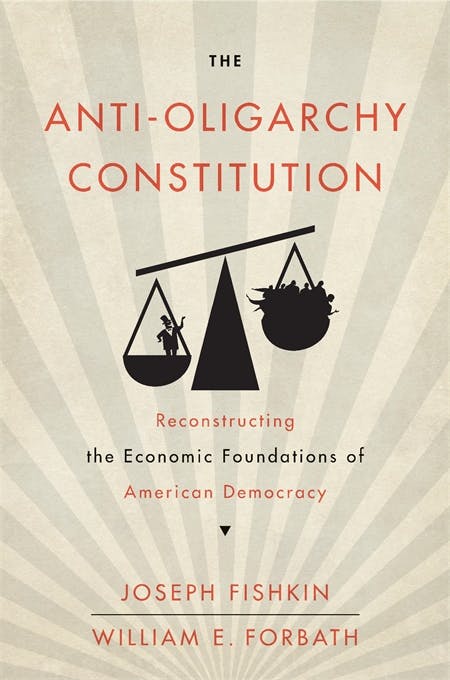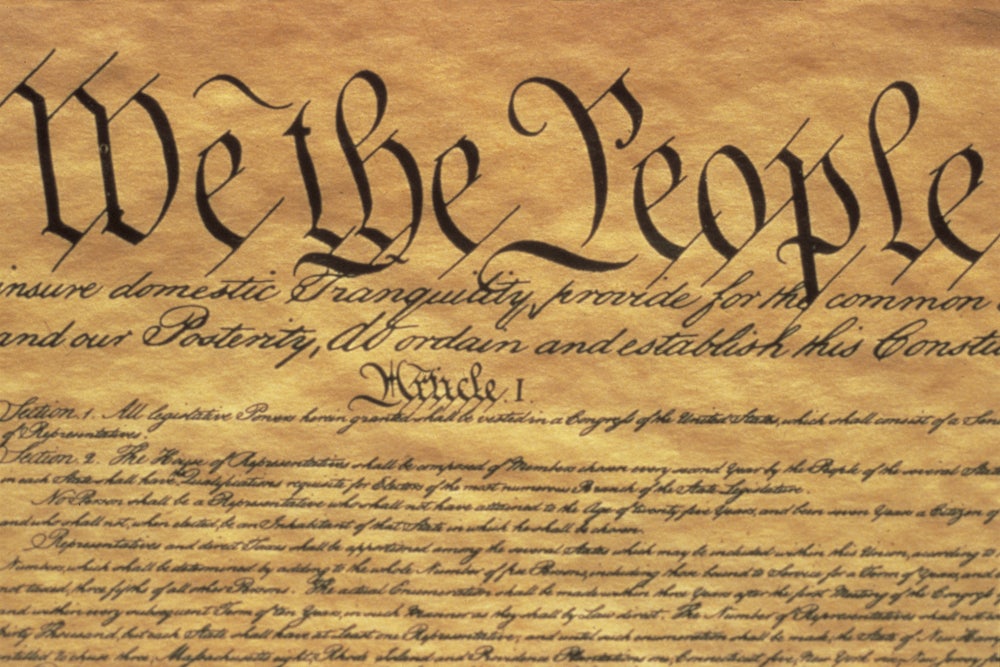It’s by now a wearily familiar ritual: The case against a foundational right or freedom—ballot access, uncorrupted elections, broadly affordable health care, reproductive rights—gains a hearing before the Oz-like conclave of U.S. Supreme Court justices. Gnat-straining procedural arguments—designed to distort or downplay the actual stakes of the constitutional challenge in question—overtake more considered and reasoned political deliberations, and presto: The substantive meaning of self-rule, equal protection, and full representation under the law once more narrows to a vanishing point.

Confronted with this steady erosion of the country’s politico-economic foundations, mainstream liberals and establishment Democrats mostly shrug in procedural befuddlement: Live by the high court, die by the high court. If they’re feeling particularly worked up, they’ll reel off a Twitter barb about Susan Sarandon, Jill Stein, or Bernie Sanders, to remind left-leaning activists and candidates that it’s their fault we can no longer have nice legal things.
But it’s the broader asymmetry here—which has an energetic, dogmatic conservative legal establishment continually seizing ground from an enervated liberal opposition—that’s the real sign of moral and imaginative decay in the America’s politics, in the courts and beyond them. Instead of ritually stigmatizing its extremist flank, the American right perennially finds new ways to empower its ardent apostles and advance its policy-cum-legal agenda; for all its plaints about the administrative state’s undemocratic excesses, it’s aggressively backloaded the judicial talent pool with hard-right nominees groomed by the Federalist Society. And meanwhile, instead of responding in kind with bold proposals to reimagine our core commitments to freedom, equality, and opportunity in an age of spiraling inequality, rampaging privatization, and depleted social goods, the proceduralist center conducts rearguard actions to preserve the appearance of comity, compromise, and bipartisan decorum.
To
grasp the full sweep of this catastrophic turn of events, it’s necessary to
reckon with some major shifts in the groundwork of our politics and their
ongoing derangement of the separation of powers. How did the courts become the
lead arbiters of constitutional observance? And how has this new mode of legal
supremacy coincided with liberals’ disengagement from the socioeconomic issues
that matter the most?
In their rousing and authoritative study The Anti-Oligarchy Constitution, Joseph Fishkin and William E. Forbath attempt to recover the Constitution’s pivotal role in shaping claims of justice and equality. As they explain at the outset, they aim to revive what Franklin D. Roosevelt called the democracy-of-opportunity tradition, an ambitious constitutional project that stretched back to the arguments over the nation’s founding. According to this way of thinking, the central objective of republican reform was to ensure a broad equality of conditions both to permit maximum participation in public life and to serve as a robust safeguard against forces of corruption and tyranny. Only a roughly equal economic life could secure a just political order—and vice versa.
Democracy-of-opportunity advocates developed a three-pronged vision of how to steer the nation’s political economy toward higher democratic ambitions: the resistance to oligarchy (in politics and productive life alike); the creation of an open, expansive middle class; and the mandate of greater inclusion, in terms of race, gender, and other identity groupings. It’s crucial, Fishkin and Forbath argue, to understand these overlapping aims within the same American tradition. It is “a grave error,” the authors write, “to see a clash between a robust constitutional politics of race and sex equality and a constitutional politics of fighting class domination.” It is not possible to further one without the other.
The democracy-of-opportunity movement did not the leave the important work of interpreting and enforcing the Constitution to the courts. This understanding of constitutional politics reached its apogee, the authors argue, during the “second founding” undertaken by Radical Republicans in the Reconstruction era. Thaddeus Stevens, the leading Radical Republican on Congress’s Joint Committee on Reconstruction, argued, “The whole fabric of southern society must be changed … if the South is ever to be made a safe republic.” Republican institutions could not function, he observed, “in a mingled community of nabobs and serfs.”
The failures of Reconstruction, and the later rise of Jim Crow, bore out Stevens’s warning in detail. Stevens’s Joint Committee had laid out the stakes in its prophetic 1866 report: “Slavery, by building up a ruling and dominant class, had produced a spirit of oligarchy averse to republican institutions,” and to endorse a body of policies leaving this class “in the exclusive possession of political power, would be to encourage the same spirit.” The disputed presidential election of 1876—in which Congress brokered a victory for Republican candidate Rutherford B. Hayes—firmly restored the oligarchic planter class into power, while Northern political elites walked back their own prior allegiances to political economic equality for their own self-interested reasons.
Black Southerners continued to organize and vote even in the face of racial terror. At the same time, reformers in the late-nineteenth-century Populist uprising sought to break the stranglehold of race-driven oligarchy in the South. As they formed class alliances across other ethnic and religious divisions, they also sought (haltingly and inexpertly, it’s true) to reach across the color line. Georgia Populist Thomas Watson, William Jennings Bryan’s 1896 running mate, exhorted Black and white audiences to join forces in the great battle between “Democracy and Plutocracy”: “You are kept apart that you may be separately fleeced of your earnings. You are made to hate each other because upon that hatred is rested the keystone of the arch of financial despotism which enslaves you both.” It speaks volumes about the centrality of such racial division in oligarchic rule that Watson himself went on to become a virulent racist and antisemite in the wake of the debacle of the 1896 election: The reactionary political economy of the Jim Crow South had both defeated and deranged him.
Come the Progressive era, a host of more sober reformist intellectuals made a hasty peace with the white Supremacist south. And as they relinquished hold on this key strand of democracy-of-opportunity agitation, they also faced a breakdown in labor jurisprudence, which galvanized around the landmark 1905 Supreme Court ruling Lochner v New York. The Lochner court found that New York State regulations that sought to impose limits on working hours were in violation of sacrosanct constitutional provisions for the freedom of contract. Backers of the emergent Lochner consensus styled themselves classical liberals—i.e., arch defenders of individual right against unmoored state prerogative. In remarkably short order, a court-driven recalibration of the basic terms of political-economic life was in full swing; it drew no small amount of momentum from the matriculation of a whole new generation of corporate lawyers to the bar in the Gilded Age, whose “wealth, and ties of family and friendship put 98 percent of them at the very top of the nation’s class and status hierarchies.” Though it does not seem unusual today that most federal judges and justices came from the corporate elite, it was a new development then: The federal judiciary became “the arena where the ruling class went to rule,” the authors write, “unleashing troops against striking workers, and overturning or gutting legislative efforts to curb and revise the courts’ work.”
This new judicial class deemed not only labor legislation but strikes and boycotts a mortal threat to the classical liberal market order, and punished them accordingly. Labor radicals and their allies decried the untrammeled rise of “government by injunction,” as the court permitted the mobilization of Pinkertons, national guardsmen, and assorted corporate-leased goon squads to put down any worker uprising by force.
This wasn’t the first time that the bromides of free contract and property were shown to be enforced by the iron fist of the state—but the Lochner era was striking in the extremes it went to naturalize such arrangements. “The courts were not merely protecting the freedom of contract and the rights of property from interference by legislative majorities,” the authors note; “they also were refurbishing and building up a distinctive common law of employment marked by hierarchy and subordination, by illiberal fixed status as much as liberal free contract. While the United States developed into a burgeoning industrial nation, employment law remained lodged in the master’s household.”
It’s little wonder, then, that the defenders of a democracy of opportunity regarded the courts as critical obstacles to their success. The solution came directly from the playbook of old-school political economy: to remake the Constitution so as to directly countermand the regressive diktats from the bench—and the broader set of economic and political arrangements that they served to rationalize and naturalize. These radical Progressive reformers adroitly called upon the affirmative duties of government under the Constitution to secure the material conditions of republican self-rule. The Progressives pushed for the Seventeenth Amendment, providing for the popular election of senators, at a moment of unexampled corruption in the chamber. Omer Kem, a Populist representative from Bryan’s home state of Nebraska, laid out the stakes of this struggle in stark terms: “False and evil systems have crept in through defects in the Constitution, by which the natural rights of the people have been taken from them, resulting in an unequal distribution of wealth in the country.” The amendment would serve to make the Constitution “conform more nearly to the principles set forth in the Declaration of Liberty and its own preamble,” Kem explained. Entrenching the status quo political economy, he continued, would merely update the conditions of tyranny that fueled the war for American independence in the first place.
This strategy of pushing for change by asserting faith in the Constitution yielded more than the popular election of senators—it also helped get women the right to vote, launch popular referenda and recall initiatives in a host of Progressive-led states, and propel state-level anti-monopoly and antitrust measures to help make up for the failure to enforce such protections at the federal level. And this Progressive-era vision of constitutional democracy also gave critical shape to the battery of state interventions engineered under FDR’s New Deal.
With the executive branch mobilized as rarely before on behalf of a dramatic leveling of the American political economy, the court now moved into the forefront of national politics. This confrontation is usually described as Roosevelt’s plan to pack the courts. In a landmark 1935 ruling, ALA Schechter Poultry Corp. v. the United States, the high court had famously struck down the National Industrial Recovery Act of 1933—and dismantled its high-profile executive branch agency the National Recovery Administration. The effect of the Schechter ruling was not merely to put the Roosevelt administration on a collision course with the Supreme Court; it also drove FDR further left in his efforts to revive the economy and stimulate consumer demand with guarantees of income transfers and increased bargaining power to America’s struggling workers. Roosevelt embraced the Wagner Act, securing collective bargaining rights for workers, though, like virtually all New Deal programs and legislation, the law omitted agricultural and domestic workers from its jurisdiction—a concession to white supremacist lawmakers and committee heads from the then-solid Democratic South.
It was far from coincidental that Roosevelt announced his plan to “pack” the court—to expand its membership by six, one for each justice over the age of 70 who had served at least a decade—just days before the justices were scheduled to hear oral arguments in NLRB v. Jones & Laughlin Steel Co., a test case on the constitutional authority of the Wagner Act. And while FDR’s plan was doomed to fail, the threat of a dramatically altered court, combined with the political capital accrued from Roosevelt’s landslide reelection in 1936, allowed the Wagner Act and the rest of the New Deal to survive. In Jones & Laughlin Steel, a recalibrated court casually overturned decades of Lochner-style reaction from the bench, upholding the NLRB’s reinstatement of workers fired in retaliation for trying to organize a union.
In other words, while FDR didn’t succeed in packing the court, he did succeed in advancing the Populist case for court reform—and the high court’s justices registered the message loud and clear. Eight decades later, the court-packing ploy strikes most mainstream commentators as a textbook case of executive branch overreach—foolhardy at best and dangerous at worst. But that’s largely because the entire understanding of the American political economy’s central role in constitutional jurisprudence has been banished from our collective political memory.
The real stakes of the court-packing conflict were questions that dogged the polity since the nation’s founding—questions of economic power. How could a republic sustain itself against forces of top-down economic domination? How can true political independence take hold among a permanent wage-earning class—something that the drafters of the Constitution never envisioned?
For proponents of the New Deal, this meant translating the principles of the Constitution for modern forms of economic organization and industrial relations. As New York Senator Robert Wagner explained, collective bargaining rights were anything but the assault on economic liberty that the New Deal’s detractors in the nation’s courts and boardrooms took them to be. “The fathers of our Nation did not regard freedom of contract as an abstract end,” he argued. “They valued it as a means of insuring equal opportunities, which cannot be attained when contracts are dictated by stronger parties.”
Wagner’s congressional allies pursued the same line of argument in championing Social Security, the Fair Labor Standards Act, and the New Deal’s other ambitious efforts to establish and safeguard a roughly egalitarian socioeconomic order. The logic was simple: Transfer economic power to workers and ordinary Americans, and the institutions will follow. And sure enough, between 1933 and 1938, union membership had skyrocketed, from 2,689,000 to more than eight million. Once the courts were no longer obstructing them, the legislative and executive branches could help secure the political and economic standing of this newly empowered body of citizens. “It was up to Congress and the White House now to interpret and implement the Constitution’s basic purposes and requirements, remaking the political economy and revising the distribution of wealth and power, by their own lights,” Fishkin and Forbath write. In this regard, the Fair Labor Standards Act—which extended basic wage and workplace standards to nonunion workers as well as unionized one—“was like the NLRA, an effort to secure ‘the economic rights of citizenship’” they note, quoting still another New Deal legislator.
The gains, however, were not to last. In what Fishkin and Forbath call “the great forgetting,” the political-economic breakthroughs of the New Deal era began to unravel. The labor accords struck among national unions and major employers stymied the further adjudication of labor rights in the courts, while the era’s unprecedented run of middle-class prosperity bred the false impression that a rising tide was spontaneously causing all boats to rise. Meanwhile, a resurgent corporate right targeted the New Deal the moment it regained power in Congress, with the 1947 Taft-Hartley Act, outlawing many closed-shop union agreements and establishing the grounds for states, mostly in the low-wage South, to enact “right to work” legislation basically rolling back the collective bargaining guarantees of the Wagner Act.
An intellectual revolution was also taking shape. The rise of neoliberal economics coincided with the discipline’s fiercely self-advertised elevation into a bastion of technocratic rule. Central challenges of the old political economy, such as antitrust and wealth distribution were now, like the rights of contract and property under Lochner, treated as more or less immutable features of the natural order of things. Antitrust, under the preachments of its economic foes like Milton Friedman and legal adversaries like Robert Bork, only mattered when it created price cartels that impeded the freedom of consumers. Corporate governance, which had adapted (albeit in distinctly lagging fashion) to the public-interest dictates of New Deal social reform, started to embrace the gospel of maximizing shareholder returns, setting the stage for a renewed redistribution of wealth upward in the country’s paper economy.
And the courts once again followed in train. “When courts resumed issuing antistrike and anti-picketing decrees … unions’ constitutional objections found no traction,” the authors write. “Labor relations were no longer a sphere of ‘popular government’ and public political engagement. Looking back, scholars would observe that labor rights had vanished into a ‘constitutional black hole.’”
The same was to hold true for a host of other formerly social goods and public spheres of political-economic inquiry, from transportation and housing to banking and monetary policy. In one respect, however, the postwar Supreme Court provided a significant advance: The overthrow of formal segregation in the schools, in the landmark 1954 Brown v. Board of Education ruling, opened the door to a host of long-overdue breakthroughs in the neglected third strand of democracy-of-opportunity agitation: securing a more inclusive republican polity, particularly in the sphere of racial justice. The Brown ruling also became a flashpoint of militant organizing in the postwar right, from “massive resistance” campaigns in the South to the demands to impeach Chief Justice Earl Warren promulgated by the John Birch Society and its far-right allies.
Yet liberals found that relying on the courts, without passing robust legislation in Congress, was a dangerous game. The Supreme Court’s 1973 abortion-rights decision in Roe v. Wade secured the right to abortion but meant that liberals were dependent on court prerogative. With Roe, Fishkin and Forbath write, “liberal constitutional politics became, and remains, heavily about defending the Court and its precedents from politics.” It also energized their opposition: “For conservatives, the lesson of Roe was the need to recruit different and more conservative judges who would cease imposing liberal values, and instead impose conservative values ostensibly found in the Constitution.” This process began in the Reagan and Bush years with the appointment of justices Antonin Scalia and Clarence Thomas, as well as the elevation of segregationist sympathizer William Rehnquist to chief justice, and came to fruition under Trump, who appointed Neil Gorsuch, Brett Kavanaugh, and Amy Coney Barrett.
The winners in this realignment have been the wealthy. “The most successful litigants before the Court since the mid-1970s have not been abortion-rights activists or racial minorities, but the Chamber of Commerce,” Fishkin and Forbath write. “Business interests have been unafraid to advance legal and constitutional arguments for a more laissez-faire constitutional political economy.” Indeed, the business capture of the Constitution has lately taken in many of the civil liberties guarantees in the Bill of Rights—notably the First Amendment guarantees of speech and freedom of worship, distorted out of all recognizable shape to secure the untrammeled corporate rights to political speech (in the disastrous 2010 Citizens United ruling) and discrimination on grounds of religious observance (in 2014’s Burwell v. Hobby Lobby Stores).
Such power grabs seem surreal bids to enshrine corporate prerogative as a first-order principle of constitutional rule, in defiance of all understandings of a republican political economy. But as Fishkin and Forbath note, they’ve been enabled in no small part by “a listless Democratic party” that “attempted with varying degrees of success to build a political coalition that bypassed questions of political economy—and viewed labor as just one Democratic constituency, and a dwindling one.” This colossal tactical error has been compounded by the lingering centrist deference to a long-outworn image of the Supreme Court as a grand impartial arbiter of constitutional outcomes.
During the past four decades and counting of neoliberal politics and legal retrenchment, it’s clear that “the United States does not have a Court that sits separate from politics,” the authors write. “Instead, we have a Court that is openly engaged in a branch-transcending struggle in constitutional politics.” Still, liberals have continued to recur to “an imagined past” and champion incremental, equivocal “court reform legislation in the name of nonpartisanship.” Fishkin and Forbath argue that such a reform initiative is “the wrong answer to the present challenge. The goal of nonpartisanship bypasses the most important part: persuading the American people of the substantive case against the constitutional politics and vision that animate the Court’s present majority.… Prescriptions for reform should flow from, and should be shaped by, a substantive view of what is wrong with the present court’s constitutional politics.”
Throughout this epic reconsideration of the foundational terms of our constitutional politics, Fishkin and Forbath range wide and deep across our legal, economic, and political history to deliver just this substantive view—and do so in engaging, imaginative prose that makes even the present court’s capture by the ideological right a compelling platform for a revived social-democratic constitutional politics. After all, the long shadow of reactionary Lochnerism was dispelled all but overnight in the face of an aroused and motivated wave of resistance grounded in our more representative and popular branches of government. As the bracing narrative of The Anti-Oligarchy Constitution makes clear, the struggle for a just and durable republican political economy has set an abundance of worthy precedents.






